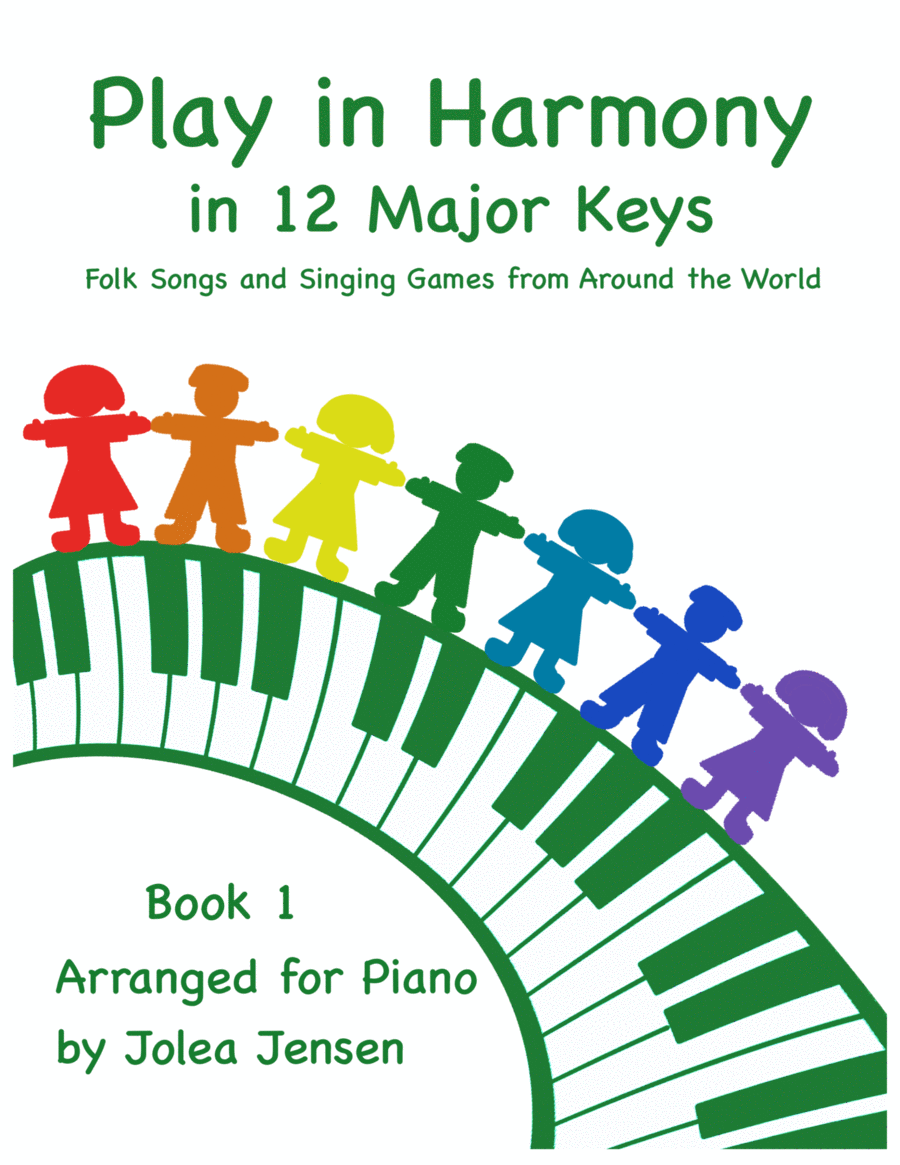Easy Piano - Level 1 - Digital Download SKU: A0.517906 Composed by Jolea Jensen. Arranged by Arr. Jolea Jensen. Children,Folk,Instructional,Multicultural,Traditional,World. Score. 106 pages. Jolea Jensen #128632. Published by Jolea Jensen (A0.517906). Learn folk songs and singing games from around the world in this early elementary book. This series features a solo melody line accompanied by I, IV, and V7 chords, making it perfect for a general classroom setting or for private lessons. Level One (Book 1, Part 1) begins with basic rhythms (quarter, half, dotted half, and whole) in the keys of C, G, D. Each key begins with several songs in the basic five-finger position, then adds either one note above or one note below, then adds 3/4 time, then adds songs in which the hand is not in the basic five-finger position for that key. Level One (Book 1, Part 2) continues with the keys of A, E, B. Eighth notes are introduced in the key of E. Level One (Book 1, Part 3) contains the keys of F#, Db, and Ab. Level One (Book 1, Part 4) contains the keys of Eb, Bb, and F. I have been teaching several of my students with this book, and they are often eager to begin their lessons by playing their assignment out of this book. The feedback I've received from parents is that their child loves the songs because they are fun and easy to understand. Children often love coloring in the black and white pictures on each page. I hope your students also enjoy these songs. Scope and Sequence for Level One songs: Introduction to I and V Simple with LH thumb melody note I and V More leaps I and V I and IV and V extend pinky I IV V extend thumb I IV V three four time simple move hand Alphabetical Song Index with Key and Pg Number: A Ram Sam Sam Ab 67 AijÄ, Žūžū, LÄÄa BÄrni E 32 Ainsi Font Bb 82 Alle Meine Entchen C 5 Ambos a Dos B 37 Ang Pato Ko Eb 70 Arroz con Leche F# 47-48 Au Clair de la Lune E 34 Bells in the Steeple Bb 83 Bill Grogan's Goat Bb 84 Björnen Sover Bb 81 Boil Them Cabbage Down C 4 Brinca la Tablita F 88 Buttercup G 8 Button, You Must Wander Ab 64 Chase the Squirrel C 1 Chopsticks C 6 Clap, Clap, Clap Your Hands D 15 Closet Key F# 42 Cobbler, Cobbler F 85 Cradle Hymn Db 52 Down by the Station F 86 Down in the Valley G 12 Five Fat Turkeys F# 45 Five Little Chickadees G 11 Frog in the Meadow Ab 59 Frogs in the Pond C 2 Go Tell Aunt Rhody D 14 Goodbye, Old Paint F 91 Grandma Grunts F 87 Ha' Sukkah Mah Yafah Ab 60 Hob Ich a Por Oksn Ab 61-62 Hop, Old Squirrel B 35 Hush-A-Bye G 10 Hush, Little Baby G 9 I'm a Nut Eb 75 Johnny's Hammer E 30 Journey of the Leaves E 33 Juan Pirulero B 40 Kangaroo Skippy Roo Bb 76 King's Land Eb 73 Kolyada A 24 Kuckuck Db 57 Lady Come A 22 Lavender's Blue Eb 74 Lightly Row C 3 Limerick Song D 19 Long-Legged Sailor F# 43 Love Somebody G 10 Mmm, Ahh, Went the Little Green Frog Bb 77-78 Mon Petit Lapin a Bien du Chagrin Ab 63 My Horses Ain't Hungry G 13 Naughty Kitty Cat F# 46 O wie wohl ist mir am Abend Db 58 Old King Cole B 38 On Top of Old Smokey D 20 One, Two, Three, Aleerie F 92 Over in the Meadow F 89-90 Pak Pak Ka-ak A 21 Passa, Passa, Gavião Db 51 Pease Porridge Hot A 25 Piva, Piva l'oli d'uliva Ab 65-66 Promenons-nous dans les Bois Eb 71-72 Sandy McNab A 26 Sasara ang Bulaklak Bb 79-80 Scotland's Burning B 36 Seashell Eb 68 Sleep, Baby, Sleep D 16 Tallis' Canon A 27 Ten in the Bed Eb 69 The Deaf Woman's Courtship A 23 The Elfin Knight Db 55-56 The Frog in the Bog D 17 The Noble Duke of York E 31 The Old Sow Took the Measles Db 53-54 The Sandman Comes D 18 Three Jolly Fishermen E 29 There's a Hole in the Bucket F# 49 Twinkle, Twinkle, Little Star B 41 Ulo Abaga B 39 Vamos a la Mar F# 44 Who's That Tapping at the Window Db 50 Yoo Hoo! E 28 Zhao Peng You C 7.
